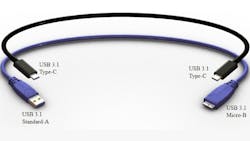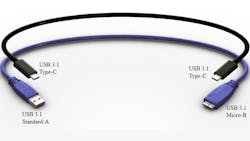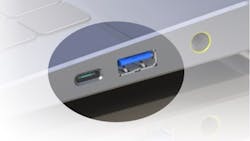USB 3 brought faster transfer rates and a new connector to the scene (see “USB 3.0: A Tale Of Two Buses”). The connector had more signals to accommodate the older USB 2.0 and newer USB 3.0 standard. Older cables could connect to new connectors and vice versa. Of course,the bandwidth was limited by the slower side.
The USB 3.1 Type-C connector (Fig. 1) targets compact mobile devices like smartphones. One major difference other than size is its reversible nature. This is new to USB connections but common in other areas. This is also true for cable connections. Older USB cables had unique connectors on each end. The new Type-C connectors also click when plugged in for audible connection feedback.
The socket for USB 3.1 Type-C connectors will probably be added next to larger USB connectors on devices like laptops (Fig. 2). They will likely be the sole USB connector on smaller devices like smartphones and tablets.
Related Articles
- USB 3.0: A Tale Of Two Buses
- What’s The Difference Between USB 2.0 And 3.0 Hubs?
- 3.0 Physical Layer Test Challenges: Gen3 and Beyond
- The Fundamentals Of Integrating USB 3.0 IP On An SoC
The connectors are approximately 8.3-mm by 2.5-mm. Target life cycles is 10,000 connections. Power capacity is designed for 3 A for the cables while the connectors can handle 5 A. They will support USB D power management and extended current handling. The cables also have improved EMI and RFI support. They will be able to handle the 5.1 Gbit/s of Gen 1 USB 3.1 as well as the 10 Gbit/s for Gen 2.
Adapters and cables with different connector combinations will be possible since this new connector is just changing the form factor, not the signals.
About the Author
William G. Wong
Senior Content Director - Electronic Design and Microwaves & RF
I am Editor of Electronic Design focusing on embedded, software, and systems. As Senior Content Director, I also manage Microwaves & RF and I work with a great team of editors to provide engineers, programmers, developers and technical managers with interesting and useful articles and videos on a regular basis. Check out our free newsletters to see the latest content.
You can send press releases for new products for possible coverage on the website. I am also interested in receiving contributed articles for publishing on our website. Use our template and send to me along with a signed release form.
Check out my blog, AltEmbedded on Electronic Design, as well as his latest articles on this site that are listed below.
You can visit my social media via these links:
- AltEmbedded on Electronic Design
- Bill Wong on Facebook
- @AltEmbedded on Twitter
- Bill Wong on LinkedIn
I earned a Bachelor of Electrical Engineering at the Georgia Institute of Technology and a Masters in Computer Science from Rutgers University. I still do a bit of programming using everything from C and C++ to Rust and Ada/SPARK. I do a bit of PHP programming for Drupal websites. I have posted a few Drupal modules.
I still get a hand on software and electronic hardware. Some of this can be found on our Kit Close-Up video series. You can also see me on many of our TechXchange Talk videos. I am interested in a range of projects from robotics to artificial intelligence.



